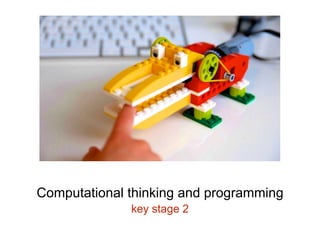
Computational thinking KS2
- 1. Computational thinking and programming key stage 2
- 2. Subject content for KS2 Pupils should be taught to: • design, write and debug programs that accomplish specific goals, including controlling or simulating physical systems; solve problems by decomposing them into smaller parts • use sequence, selection, and repetition in programs; work with variables and various forms of input and output • use logical reasoning to explain how some simple algorithms work and to detect and correct errors in algorithms and programs
- 3. Decomposing problems “solve problems by decomposing them into smaller parts” - Subject content KS2 Decomposition is the process of breaking a problem down into smaller problems so that ultimately the bigger problem can be solved (and explained clearly to someone else or to a computer).
- 4. Sequence, repetition & selection “use sequence, selection, and repetition in programs” - Subject content KS2 Sequence: putting instructions in an order where each one is executed one after the other Repetition: one or more instructions are repeated a number of times or until a condition is met or the program is stopped Selection: instructions are executed depending on whether a particular condition is met Selection lies at the heart of the ‘intelligence’ of a computer program.
- 5. Activity #1 Hour of Code Working in pairs, follow the Hour of Code beginners tutorial. Your challenge is to complete this in 30 mins! http://learn.code.org/hoc/1 NB: This tutorial introduces the key programming concepts of sequence, repetition and selection
- 6. Debugging at KS2 “design, write and debug programs that accomplish specific goals” - Subject content KS2 This builds upon children’s experience of debugging at KS1. As their programs become more sophisticated the debugging becomes more challenging.
- 7. Activity #2 Hungry Monkey 1 http://scratch.mit.edu/projects/23390939/ Can you make the monkey sprite move left and right when the left and right arrow keys are pressed?
- 8. Activity #3 Hungry Monkey 2 http://scratch.mit.edu/projects/23390750/ Can you make the monkey jump to catch the bananas?
- 9. Variables “work with variables” - Subject content KS2 Variables are containers for data. They enable us to store, retrieve or change data. A variable could be used in a game to keep track of a user’s score or to remember a player’s name.
- 10. Activity #4 Hungry Monkey 3 http://scratch.mit.edu/projects/23390032/ Can you make the score board work to keep track of the number of bananas monkey has caught?
- 11. Subject content for KS2 Pupils should be taught to: • design, write and debug programs that accomplish specific goals, including controlling or simulating physical systems; solve problems by decomposing them into smaller parts • use sequence, selection, and repetition in programs; work with variables and various forms of input and output • use logical reasoning to explain how some simple algorithms work and to detect and correct errors in algorithms and programs
- 12. Follow up from today: • Evaluate how your own and your group’s digital literacy is reflected through the web resource you are developing Before the next session: • Investigate how schools encourage learning partnerships between and with children, staff, families and other professionals • Glazzard et al (2010) assessment for learning in the • Early Years Foundation Stage, London: Sage Chapter 3
